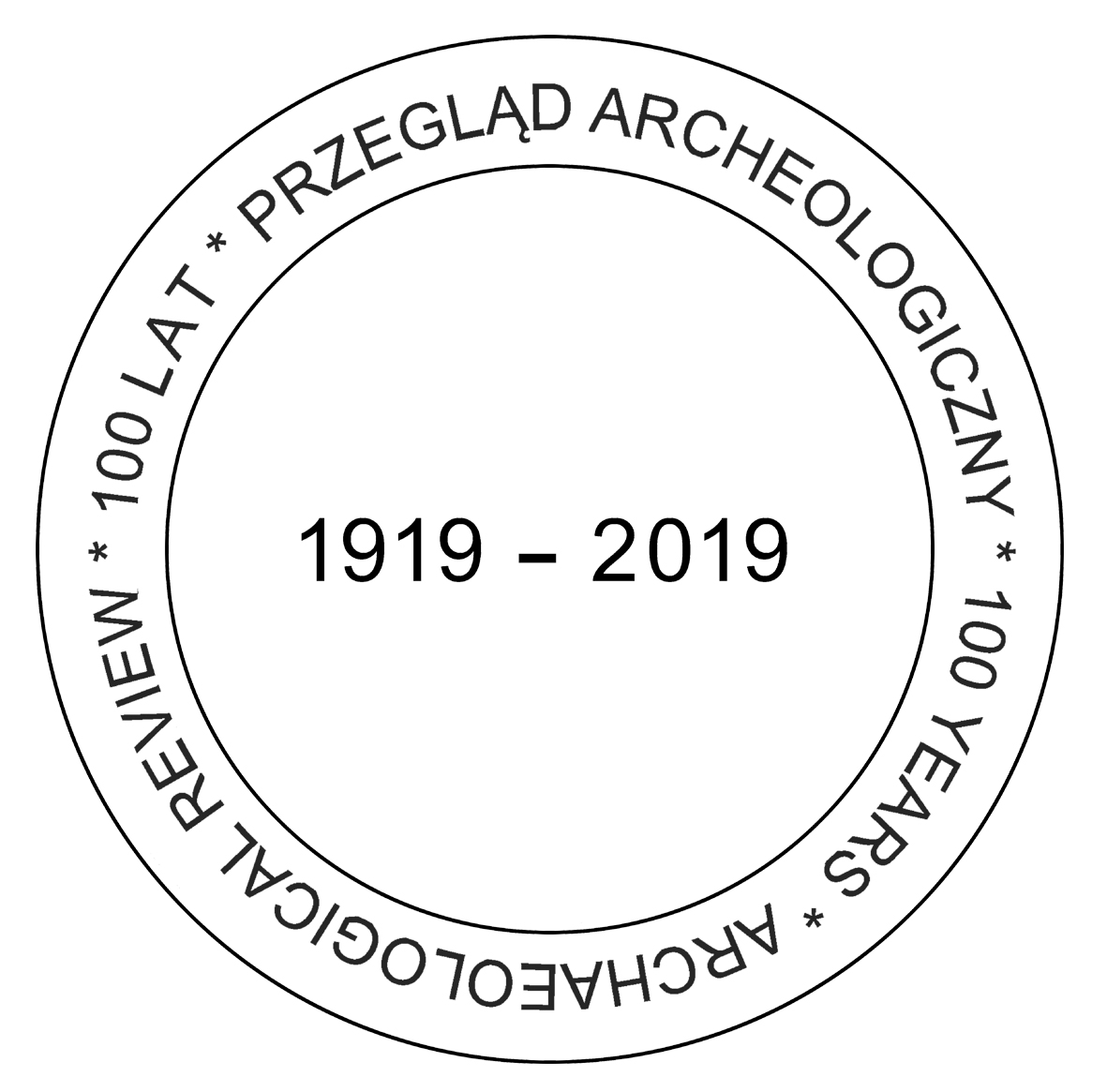Chronologia i periodyzacja cmentarzyska z epoki brązu i wczesnej epoki żelaza w Domasławiu, pow. wrocławski, na podstawie datowania radiowęglowego
Słowa kluczowe:
radiocarbon dating, Bayesian analysis, Bronze Age, DomasławAbstrakt
The article presents the results of the radiocarbon dating and Bayesian analysis of 14C dates of bones from the burial ground in Domasław. The Bayesian analysis used the relative chronology obtained based on the characteristic features of grave goods and the assigning of individual burials to specific periods of the late Bronze Age (III EB – V EB ) or the early Iron Age (HC – LtA). A coherent chronological model of the burial ground was accepted after assuming that graves with transitional features, attributable to two subsequent periods, could have been contemporary of graves from one or the other period. The temporal frames of particular periods calculated by the model allow us to improve previously published chronological diagrams of the late Bronze Age and the early Iron Age in the region.
Pobrania
Bibliografia
Bayliss A. (2015). Quality in Bayesian chronological models in archaeology. World Archaeology, 47(4), 677- 700.
Brock F., Higham T., Ditchfield P., Bronk Ramsey C. (2010). Current pretreatment methods for AMS radiocarbon dating at the Oxford Radiocarbon Accelerator Unit (ORAU ). Radiocarbon, 52, 103-112.
Bronk Ramsey C. (1995). Radiocarbon calibration and analysis of stratigraphy: the OxCal program. Radiocarbon, 37, 425-430.
Bronk Ramsey C. (2009). Bayesian analysis of radiocarbondates. Radiocarbon, 51, 337-360.
Bronk Ramsey C., Higham T., Bowles A., Hedges R.E.M. (2004). Improvements to the pretreatment of bone at Oxford. Radiocarbon, 46, 155-163.
Bronk Ramsey C., Lee S. (2013). Recent and Planned Developments of the Program OxCal. Radiocarbon, 55, 720-730.
Chochorowski J. (2007). Metodyczne i metodologiczne problemy datowania radiowęglowego pozostałości kremacji z grobów ciałopalnych kultury łużyckiej (na przykładzie materiałów z cmentarzyska w Kietrzu). W: J. Chochorowski (red.), Studia nad epoką brązu i wczesną epoką żelaza w Europie (103-138). Kraków: Wydawnictwo Uniwersytetu Jagiellońskiego.
Dąbrowski J. (2009). Polska przed trzema tysiącami lat. Czasy kultury łużyckiej (Poland three thousand years ago: the Lusatian Culture and his times). Warszawa: Wydawnictwo „Trio”.
Gediga B. (1982). Zagadnienia periodyzacji okresu rozwoju kultury łużyckiej w świetle kontaktów z Południem. W: M. Gedl (red.), Południowa strefa kultury łużyckiej i powiązania tej kultury z Południem (49-59). Kraków- Przemyśl: Materiały z konferencji, która odbyła się w Krakowie, Nowej Hucie i Nowym Sączu w dniach od 11 do 14 IV 1978 r.
Gediga B. (2013). The Culture of the Early Iron Age in the South-Western Regions of Poland in the Light of New Research. W: S. Bergebrant, S. Sabatini (red.), Counterpoint: Essays in Archaeology and Heritage Studies in Honour of Professor Kristian Kristiansen (383- 399). BAR International Series 2508, Archeopress.
Gediga B. (2019). Uwagi do datowania i periodyzacji użytkowania cmentarzyska w Domasławiu- Chrzanowie, pow. wrocławski. Przegląd Archeologiczny, 67, w tym tomie.
Goslar T., Czernik J., Goslar E. (2004). Low-energy 14C AMS in Poznan Radiocarbon Laboratory, Poland. Nuclear Instruments and Methods in Physics Research B, 223–4, 5-11.
Goslar T., Jankowski M., Kośko A., Lityńska-Zając M., Włodarczak P., Żurkiewicz D. (2017). Builders and users of ritual centres, Yampil Barrow Complex: studies of diet based on stable carbon and nitrogen isotope composition. W: A. Kośko (red.), Podolia „Barrow Culture” communities: 4th/3rd mill. BC. The Yampil Complex: interdisciplinary studies (64-90). Baltic- Pontic Studies, 22.
Kostrzewski J. (1948). Od mezolitu do okresu wędrówek ludów. W: S.W. Krukowski (red.), Prehistoria ziem polskich. Kraków: Nakładem Polskiej Akademii Umiejętności.
Kostrzewski J., Chmielewski W., Jażdżewski K. (1965). Pradzieje Polski (Prehistorie de la Pologne). Warszawa: Zakład im. Ossolińskich.
Kruk J., Milisauskas S., Włodarczak P. (2018). Real time. Radiocarbon dates and bayesian analysis of the neolithic settlement at Bronocice, fourth millennium BC. Kraków: Instytut Archeologii i Etnologii PAN .
Lanting J.N., Van der Plicht J. (2001). Dating of cremated bones. Radiocarbon, 43, 249-254
Longin R. (1971). New method of collagen extraction for radiocarbon dating. Nature, 230, 241-242.
Makarowicz P., Goslar T., Niebieszczański J., Cwaliński M., Kochkin I.T., Romaniszyn J., Lysenko S.D., Ważny T. 2018. Middle Bronze Age societies and barrow line chronology. A case study from the Bukivna ‘necropolis’, Upper Dniester Basin, Ukraine. Journal of Archaeological Science, 95, 40-51, doi: 10.1016/j.jas. 2018.04.010.
Marciniak A., Barański M.Z., Bayliss A., Czerniak L., Goslar T., Southon J., Taylor R.E. (2015). Fragmenting times: interpreting a Bayesian chronology for the Late Neolithic occupation of Catalhöyük, East Turkey. Antiquity, 89(343), 154-176.
Olsen J., Heinemeier J., Lübke H., Lüth F., Terberger T. (2010). Dietary habits and freshwater reservoir effects in bones from a Neolithic ME Germany cemetery. Radiocarbon, 53, 635-644.
Pospieszny Ł., Bełka Z. (2015). Dieta i mobilność u schyłku starożytności. Szczątki ludzkie z cmentarzyska w Karczynie/Witowach stan 21/22 w świetle badań izotopowych. W: J. Bednarczyk, A. Romańska (red.), Karczyn/Witowy stan. 21/22. Birytualne cmentarzysko kultury przeworskiej z Kujaw (197-218). Studia i Materiały do Dziejów Kujaw 12. Poznań-Inowrocław.
Reimer P.J., Bard E., Bayliss A., Beck W.J., Blackwell P.G., Bronk-Ramsey C., Buck C.E., Cheng H., Edwards R.L., Friedrich N., Grootes P.M., Guilderson T.P., Hafidason Hafifi, Hajdas I., Hattè C., Heaton T.J., Hoffmann D.L., Hogg A.G., Hughen K.A., Kaiser K.F., Kromer B., Manning S.V., Niu M., Reimer R.W., Richards D.A., Scott E.M., Southon J.R., Staff R.A., Turney S.M., Van der Plicht J. (2013). IntCal13 and marine 13 Radiocarbon age calibration curves 0-50,000 years cal BP . Radiocarbon, 55, 1869-1887.
Shishlina N., Sevastyanov V., Zazovskaya E., van der Plicht J . (2014). Reservoir effect of archaeological samples from steppe bronze age cultures in southern Russia. Radiocarbon, 56, 767-778.
van Klinken G.J. (1999). Bone collagen quality indicators for palaeodietary and radiocarbon measurements. Journal of Archaeological Science, 26, 687-695.
Zazzo A., Saliège J.F., Person A., Boucher H. (2009). Radiocarbon dating of calcined bones: where does the carbon come from? Radiocarbon, 51, 601-611.
Zazzo A., Lebon M., Chiotti L., Comby C., Delqué-Količ E ., Nespoulet R., Reiche I. (2013). Can we use calcined bones for 14C dating the Paleolithic? Radiocarbon, 55, 1409-1421.
Pobrania
Opublikowane
Jak cytować
Numer
Dział
Licencja

Praca jest udostępniana na licencji Creative Commons Attribution-ShareAlike 3.0 Unported License.















